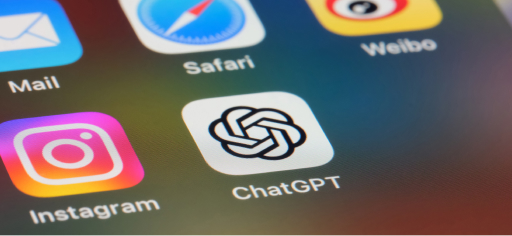Have you met ChatGPT?
Imagine having a conversation with a computer program that not only understands what you’re requesting but also provides relevant responses you can use for your business. That’s ChatGPT!

You may have heard a lot of buzz about ChatGPT lately and with good reason. It uses artificial intelligence to understand and respond to human language in a way that feels natural and human-like. It’s fast, free (for now), and fun to play with. More importantly, it can be a powerful tool in your personal training business.
From helping you create your business and marketing plans to researching the latest fitness trends and studies and creating content, ChatGPT can be your on-call business buddy, always ready with knowledge and idea starters.
How can YOU make the most out of ChatGPT?
Just like us humans, the more ChatGPT interacts with people, the better it becomes at understanding and generating meaningful responses. Similarly, with a personal trainer app, the more your clients engage, the more effectively you can track their progress and adjust their plans.It uses information it has learned from a variety of sources to give you the best possible responses, but it needs your clear instructions and guidance.
1. DON’T BE VAGUE
It’s a computer program, not a mind-reader. It won’t provide optimum responses unless you are clear about your requirements.
- Be specific: Clearly express your issue or request. The more specific and detailed your input, the better ChatGPT can understand and generate relevant responses.
- Ask follow-up questions: If the initial response doesn’t fully address your query, ask follow-up questions to clarify or provide more context. This helps ChatGPT understand your needs better and provide more accurate responses.
- Provide examples: Where applicable, provide specific examples or scenarios related to your question. This can help ChatGPT generate responses that are tailored to your situation.
- Correct and guide: If you don’t like the response ChatGPT provides, you can point out the mistake and provide guidance. This helps ChatGPT learn and improve over time.
2. SET THE RIGHT TONE
Let’s be honest, content written by a computer could easily come off sounding a little… well, robotic.
Programs like ChatGPT aren’t really time-savers if you need to rewrite everything so that it sounds less generic and more human. Take the time to work out what kind of tone you’re after and then clearly communicate this to ChatGPT from the beginning.
With some guidance, you can ensure ChatGPT’s output aligns with your brand’s tone of voice.
- Describe the tone you want to adopt in your instructions. For example, you might say, “Please provide a friendly, conversational response” or “I would like a professional and formal tone.”
- Provide examples of how you would phrase the response and ChatGPT will try to match the style and tone.
- If the response doesn’t align with your desired tone, adjust your phrasing or modify your input. Experimenting with different wording can help guide the program toward the tone you have in mind.
| Pro tip: The questions or directions you feed into ChatGPT are also known as ‘prompts’ |
3. PROMPT LIKE A PRO
You can never be too specific when it comes to providing prompts to ChatGPT. It’s absolutely starving for details, and the more you provide, the more you’ll unlock its full potential.
Here are a few phrases that you can team with your questions to satisfy the hungry beast:
- Act as if … or Pretend you are…
For example: “Act as if you are a new personal trainer just starting out [ask your question]” or ”Pretend you are a Personal trainer and [ask your question]”
- Tell me what you need…
For example: “Tell me what you need me to provide you in order for you to [add your goal]”
Here is an example of the two together: Act as if you are a personal trainer looking to open your first bricks and mortar location. Tell me what you need from me to create a business plan for potential investors.
ChatGPT will then ask you a series of questions that will help it to build a response.
How can ChatGPT work for your personal training business?
Sure, ChatGPT can’t slip on a sweatband and train your clients for you (yet…), but there are several areas that this amazing tool can be of benefit:
- Business building
- Content creation
- Client communication
1. BUSINESS BUILDING
Launch your business with ease by asking your business buddy some targeted questions.
Whether you need assistance with formulating a marketing plan, identifying current trends in the industry, or crafting a compelling value proposition, ChatGPT has got your back. It’s even clever enough to tell you what information it needs.
Some specific prompts or questions you could provide include:
- Generate [x] marketing slogans that explain the unique selling point of [product/service].
- What information do you need from me to create a business/marketing plan for my personal training business? Then answer the questions it provides you.
- Identify 5 current trends in the personal training market and how a new business could capitalize on them.
- Create a value proposition for a [company] providing [product/service details]. Make sure that it communicates all the benefits of choosing the [product/service]
2. CONTENT CREATION
Creating content for your business can be fun, but it’s also a time-consuming and endless task. Some people even find it too overwhelming to contemplate. However it’s essential for attracting new clients and ensuring engagement with current ones.
ChatGPT can provide topic ideas, write engaging blog posts, craft social media plans, and generate video or podcast scripts tailored to your target audience and desired tone.
Try some of the prompts below to get started:
- SEO (search engine optimization)
- Identify the top keywords related to [topic – e.g. personal training] that will drive relevant traffic to [your website address] and help it rank better on search engine result pages.
- Provide some suggestions on how to improve the following content for readability and SEO optimization targeting [define audience].
- Create a list of the [x] most commonly asked questions related to [topic e.g. personal training]. *You can then use these questions as the topics for your content creation*
- Blog posts
- Suggest [x] topic ideas for a blog post on [subject]. The target audience is [define audience]. The tone is [define tone – motivational, informative, funny, etc].
- Write a [define tone – motivational, informative, funny, etc.] blog post on [topic]. Length of the blog post must be 2000 words and the target audience is [define audience].
- Create a detailed SEO content brief using the primary keyword [keyword] and secondary keywords [keywords].
- Social Media
- Generate a detailed social media plan for the topic [topic]. Include the type of social media content to post, the topics to cover, and the right times to post, targeting [target audience].
- Create a post for social media to promote my upcoming event [event name] targeting [define audience]. Make it [define tone – fun, engaging, humorous, cheeky].
- Create [x] social media captions [social media platforms] for [link to content or pasted content]. Include hashtags and CTA where possible. Make the captions [define tone – fun, engaging, humorous, cheeky]. The target audience for the posts is [target audience].
- Video / podcast creation
- Create a fun and engaging [specify duration e.g. 30-sec] script to promote my upcoming event [add event details] talking to [target audience] on [platform].
- Create a video script highlighting the features and benefits of [topic].
- Generate a list of [x] ideas for video content on [topic] targeting [target audience] to post on [platform].
3. CLIENT COMMUNICATION
Emails are great way to connect with new clients, keep in contact with current clients and communicate important information about your business. But have a look at your own inbox – people are bombarded with emails from companies daily. How do you make yours stand out?
Ensure your client communications are engaging, compelling, and include strong calls-to-action. Getting clients to simply open your email can depend on something as simple as an engaging subject line.
Turn to ChatGPT with some of the following suggestions:
- Generate [x] click-worthy email subject lines for an email targeting [audience] on the topic [topic].
- Rewrite the email below in a [define tone – friendly, informative, professional] tone. Make it engaging and compelling, include a strong call-to-action. [Paste the email you want reworded.]
- Write an onboarding email for new clients for [include your business name]. Cover the below points and links. Make the tone of the email [define tone – friendly, informative, professional] and keep it below [x] words. [Paste points and links you want to be included.]
| Pro tip: Combine your prompts with the key phrases mentioned above as well are who you are targeting to ensure ChatGPT always gives you the most relevant data possible. |
Could ChatGPT replace personal trainers altogether??
Short answer: absolutely not!
When you search for AI and personal training you will likely come across content claiming that ChatGPT can do away with human personal trainers and nutrition coaches. Like all things found on the internet, this needs to be analyzed for logic and truth.
Things AI programs can do:
- Create a training program
- Create a meal plan
- Create content quickly
Things only human trainers can do:
- Track and measure client results and progress
- Tweak a client’s program to suit their progress and individual situation
- Actually, show clients how to perform specific exercises and check their form
- Have conversations with clients about their struggles and successes
- Connect and form real relationships based on trust and respect
- Give out cool and exclusive merch to wow clients
Seriously though, who would you rather have looking after your health and wellbeing: A human who HAS an actual body or a bunch of code in a box? Though as we’ve outlined above, with the right instructions AI tools like ChatGPT can definitely work FOR you instead of AGAINST you.
It’s important to remember that while ChatGPT is quite advanced, it’s just a computer program and may not always have the same understanding or context as a human. It’s also essential to double-check information, review the content it provides and rely on human judgment when needed.
What are you waiting for?
The good news is… you can’t break it. And did we mention how much fun it can be to use? So jump in, give it a go, experiment with different prompts and get your new business buddy working for you. For more on using technology in your personal training business download our ebook: The Tech-Driven Personal Trainer: How to Thrive in the Digital Age
Sign-Up for Our Newsletter
Recommended Resources For You

Blog
How AI Can Help You Craft Customized Fitness Programs and Maximize Revenue
Author: Bobby O’Connell
In today’s fast-paced fitness industry, staying ahead means embracing innovation. Artificial Intelligence (AI) is revolutionizing the way personal trainers and coaches create workout programs, manage clients, and grow their businesses. By leveraging AI, you can build personalized fitness programs efficiently, ensure client satisfaction through better results, and ultimately maximize your revenue. Let’s explore how AI […]

Blog
8 Best ChatGPT Prompts for Personal Trainers
Author: Bobby O’Connell
As a personal trainer, staying connected with your clients and maintaining robust engagement is crucial for their progress and your business growth. ChatGPT, an AI-powered conversational tool, can be a game-changer in this regard. Whether it’s daily check-ins, social media interaction, or sharing valuable fitness tips, ChatGPT can assist you in crafting the perfect messages […]

Resource
ChatGPT for Personal Trainers: Unlocking the Future of Personal Training with AI
Presented by: Dr. Ted Vickey, Founder CEO of FitWell LLC
Step into the future of fitness with our electrifying webinar, tailored exclusively for our TrueCoach Coaching and Personal Training community. In this session, Dr. Ted Vickey will unleash the incredible potential of Artificial Intelligence (AI) in revolutionizing your training approach.

Author: Bobby O'Connell FRSA CSM
-
First published: August 07 2023
Written by: Bobby O'Connell

